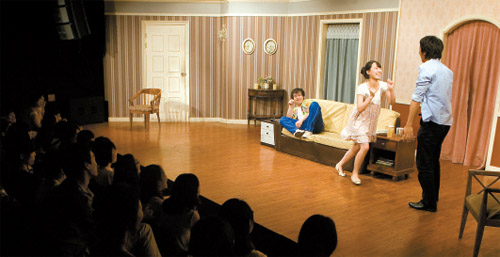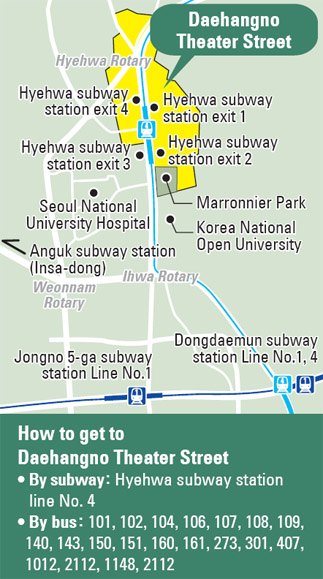A street where dreams come to life

Daehangno, the famed theater street in Hyehwa-dong, central Seoul, is always bustling with theatergoers, as it was last Saturday as shown in this photo. By Jeon Min-kyu
But several plays the Gangwon Province native saw along Seoul’s theater street during a vacation in 1991 were so inspirational that he immediately quit his job and took root in the theatrical district.
From a mere staff member to a leading actor, Lee’s second life has taken him deeply into the art scene ever since. Now 40 years old, Lee is the chief producer of “Liar,” currently the most successful play in Daehangno.
“From 18 years ago until this day, Daehangno has been a place for people hoping to see a dream come true of others or to find one of their own,” Lee said. It was in Daehangno, he said, that he found his dream. “It’s going to be the place where I will stay for the rest of my life,” he said.
Daehangno, nestling on just 1.5 square kilometers between Hyehwa Rotary and Ihwa Rotary in Hyehwa-dong, Jongno District in central Seoul, is disproportionately large in the minds of Koreans.
A must-go place for people seeking a lift, it is the biggest cluster for cultural facilities and infrastructure in the nation, densely crowding around Hyehwa subway station at line No. 4. Theaters are what Daehangno is most known for.
The local equivalent of Broadway in New York or the West End in London, Daehangno has more than 120 theaters. Most are small, with fewer than 300 audience seats. But they total more than double the number of theaters in Broadway or the West End.
Some insiders even joke that Daehangno should apply for recognition by the United Nations Educational, Scientific and Cultural Organization (Unesco) as the world’s largest theater district.
Every weekend, many of the Daehangno theaters are filled with theater lovers or those hoping to find something culturally satisfying besides movies. Some theaters attract as large an audience on weekdays as on weekends. In fierce competition, the theaters are almost never closed.
Lee Sung-ki, 24, was one of many Daehangno theatergoers last Tuesday.
It was raining heavily, and Lee said he risked getting soaked to see “Sunjeongmanhwa,” a play adapted from the comic book of the same title by Kang Pool. His girlfriend tagged along.
It was the first time the security guard of a Seoul company visited Daehangno, although he has lived in Seoul all of his life.

A sold-out audience watches actors perform Liar, an adaptation of Run for Your Life, a play written by British playwright Ray Cooney, at Samtoh Blue Bird Theater at Daehangno, central Seoul, last Saturday. Liar is one of the longest-performing plays at Daehangno and has been performed for 11 years at the theater. By Jeon Min-kyu
“Maybe I’ll come back soon,” he said.
Though many statistics are scant on Daehangno theaters, some are clear. According to the Arts Council Korea, there are approximately 1,000 to 2,000 tickets for Daehangno theaters sold daily.
Given that the ticket prices range from 15,000 won ($12) to 45,000 won, those theaters gross around 45 million won daily and over 10 billion won a year. Though when compared to very large companies, gross sales on Daehangno theater street might seem insignificant, such figures were not achieved overnight.
Meaning “college street,” Daehangno used to be a student quarter until three decades ago. There are still several close-by universities, like Sungkyunkwan University. But Daehangno was primarily named because of its once-close proximity to Seoul National University, Korea’s best known school that moved to Gwanak District in the south in 1970s.
The void left by the SNU campus was filled by a newly built Marronnier Park and the headquarters of the Arts Council Korea, a state-run arts promotion agency. Many theaters previously clustered in Sinchon and Myeongdong, two of Seoul’s busier areas, flocked to the venue in early 1980s, forming the early shape of Daehangno as a theater street. Among the first theaters moving to Daehangno were Samtoh Blue Bird Theater and Batanggol Theater.
Daehangno’s transformation into a theater district was accelerated by its designation by Seoul city as a culture street in 1985 when the Hyehwa subway station opened. It was further boosted by its designation as a special cultural district for theater and performing arts in 2004.
Having many theaters competing, Daehangno has also become a destination for those seeking an acting career or a stepping stone to success on TV or in the movies. Many of the country’s most renowned movie actors - such as Song Kang-ho, Seol Kyeong-gu, and Cho Jae-jin - initially built reputations in Daehangno theaters.
Jeong In-gyeom, a Daehangno theater actor since 1994, said around 2,000 students graduate with acting majors annually across the country and around half of them flock to Daehangno dreaming of becoming the next big thing. There are around 400 theatrical troupes based in Daehangno.
This compares to only several hundred job seekers 15 years ago, he said.
“Most of actors and staff at the beginning level receive 15 million won or less annually, so it is supposed to be an industry to be shunned,” Jeong said. “But, there is no shortage of actors and workers at Daehangno. That’s because there is more than money to the life in the theater.”

But Daehangno is not limited to dramatic plays alone. Over the past decade, a growing number of other performing art genres - including musicals, comedy shows and magic shows - have been introduced to Daehangno. Industry watchers said it is an encouraging phenomenon, but still a lack of diverse content at Daehangno could hamper its future.
“It is true there has been a quantitative expansion at Daehangno,” said Park Kei-bai, president of the National Theater Association of Korea. “But without fundamental solution to diversify content and raise quality, it will become harder for Daehangno street to keep thriving.”
By Moon Gwang-lip [joe@joongang.co.kr]










with the Korea JoongAng Daily
To write comments, please log in to one of the accounts.
Standards Board Policy (0/250자)